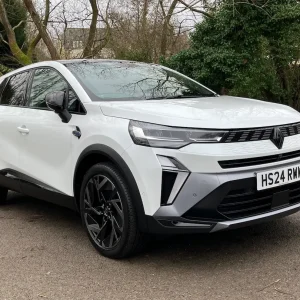The second-generation, and outgoing Countryman attracted the most fleet interest in the plug-in hybrid Cooper SE. Well now it’s back in third-generation form, promising to offer more for the corporate sector, including incoming full EV ‘E’ and ‘SE’ versions. The Countryman is the least ‘Mini’ in terms of its size, which we were told has grown thanks to customer feedback. As a result, this Countryman is 6cm taller and 13cm longer, with 25% more boot space.
Outside, the Countryman is the first Mini to debut the new family look dubbed ‘Charismatic Simplicity,’ which basically equals a simpler, cleaner design, without any of the chrome trim Mini models have previously been known for.
The basic shape follows the look set by the last two generations, but highlights include the octagonal front grille and new headlight design. At the side, the most distinctive feature is the wide wheel arches, while at the back there are customisable vertical LED rear light clusters. Overall, the latest model is more aggressive and distinctive.
If the exterior of this new Mini doesn’t attract attention – the interior certainly will. Heavily influenced by the original Classic Mini, you won’t miss the circular OLED display in the centre of the Countryman’s dashboard. Running Android-based Mini Operating System 9, all the functions of the car can be operated by touch or voice control. In use, there’s a lot going on in a circular screen with a diameter of 240mm. However, it is logical to use once you spend some time with it and generally slick in its operation. Although we’d recommend choosing the head-up display, which brings key information closer to the driver.
Below this, there’s also the Classic Mini-influenced toggle bar, which is home to the key driving functions, such as the parking brake, gear selector, and the start/stop key – which you twist and is a novel touch harking back to the original. Elsewhere, there is plenty of attractive fabric trim on the dashboard and door cards, and comfortable one-piece front seats with even more support in the range-topping John Cooper Works version. Spacious front and rear, the rear headroom is a particular highlight even with the sunroof fitted. Overall, the interior feels special and not just a BMW X1 clone, even though the commonality is obvious in items such as the switchgear.
Built on the same UKL2 platform and in the same German factory as the BMW X1, the Countryman range starts with C (not Cooper anymore, that is reserved for the new electric, and updated ICE hatches), which is powered by a revised version of the 1.5-litre, three-cylinder, TwinPower turbo petrol, with mild-hybrid assistance and 170hp. This is capable of a 0-62mph acceleration time of 8.3 seconds, has a top speed of 131mph and a tax liability of 33%. S ICE, plus E and SE EV versions will follow later this year. The other Countryman we drove, was the range-topping John Cooper Works, with its 2.0-litre TwinPower turbo petrol engine producing 300hp, 0-62 acceleration in 5.4 seconds and tax liability of 37% – making it likely to have the least fleet interest.
The direct and precise feel to the steering impresses first. Then, there’s the tidy handling, and the ride, which despite the optional 20in wheels, is comfortable, compliant, and all with plenty of grip. It feels a step up from the outgoing car.
Performance-wise, the C feels willing, but perhaps not as quick as the figures would suggest. However, the seven-speed automatic gearbox mated with the engine is slick and responsive. It feels at its most dynamic in ‘Go Kart,’ which is one of eight drive modes. The John Cooper Works, on the other hand, felt fast, although we weren’t so keen on the piped engine sound, also in ‘Go Kart’ mode.
Mini has added a big dose of style and practicality to the Countryman and the result will make a far bigger impression on fleet than the generations before it.
Mini Countryman 1.5 C Exclusive (Level 2)
P11D: £36,825
Residual value: 49%
Depreciation: £18,400
Fuel: £9,086
Service, maintenance and repair: £2,542
Cost per mile: 50.04p
Fuel consumption: 44.8mpg
CO2 (BIK %): 142g/km (33%)
BIK 20/40% a month: £202/£405
Luggage capacity: 450 litres
Engine size/power: 1,499cc/170hp





